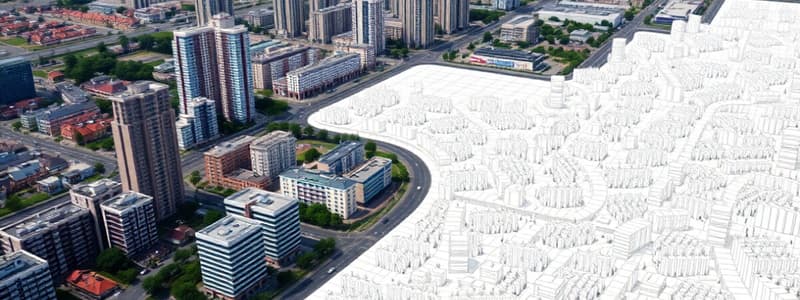Podcast
Questions and Answers
The average increase in population per decade is referred to as:
The average increase in population per decade is referred to as:
- Growth rate
- Incremental value
- Geometrical factor
- Arithmetical increase (correct)
Using the arithmetical method, if the average increase per decade is 4000 and N (number of decades) = 2, what is the total population added to the base population?
Using the arithmetical method, if the average increase per decade is 4000 and N (number of decades) = 2, what is the total population added to the base population?
- 10000
- 2000
- 8000 (correct)
- 4000
The geometrical increase method assumes that population increases by:
The geometrical increase method assumes that population increases by:
- A fixed number
- A variable rate
- Randomly
- A constant percentage (correct)
The exponential population growth method shares its principle with which of the following methods?
The exponential population growth method shares its principle with which of the following methods?
Based on the provided data, which method projected the smallest population size for 2026?
Based on the provided data, which method projected the smallest population size for 2026?
Based on the provided data, what was the average incremental increase in population per decade?
Based on the provided data, what was the average incremental increase in population per decade?
In population projection, 'incremental increase' refers to:
In population projection, 'incremental increase' refers to:
Which population projection method is most appropriate when the population growth rate is declining?
Which population projection method is most appropriate when the population growth rate is declining?
The graphical method of population projection is best applied when:
The graphical method of population projection is best applied when:
The formula $P_n = P_0 + N \cdot I_a + \frac{N(N+1)}{2} \cdot I_i$ is characteristic of which population projection method?
The formula $P_n = P_0 + N \cdot I_a + \frac{N(N+1)}{2} \cdot I_i$ is characteristic of which population projection method?
Referring to the example case, what value of 'N' (number of decades) was used for projecting the population in all methods?
Referring to the example case, what value of 'N' (number of decades) was used for projecting the population in all methods?
In the context of population data, what does the term 'souls' represent?
In the context of population data, what does the term 'souls' represent?
In the given scenario, why was the incremental increase method chosen for the final development plan projection?
In the given scenario, why was the incremental increase method chosen for the final development plan projection?
If the population in 2011 was 27500 and it increased to 31142 in 2021, what is the average population increase per decade?
If the population in 2011 was 27500 and it increased to 31142 in 2021, what is the average population increase per decade?
What was the projected population for 2026 using the graphical method in the case study?
What was the projected population for 2026 using the graphical method in the case study?
What is the primary limitation of the geometrical increase method in population projection?
What is the primary limitation of the geometrical increase method in population projection?
The arithmetical method of population projection assumes that population increases:
The arithmetical method of population projection assumes that population increases:
According to the provided data, what was the projected population ($P_s$) for 2026 calculated using the Arithmetical Increase Method?
According to the provided data, what was the projected population ($P_s$) for 2026 calculated using the Arithmetical Increase Method?
In which of the following population projection methods is the term $(1 + R_a)^N$ used?
In which of the following population projection methods is the term $(1 + R_a)^N$ used?
Based on the case presented, what final population projection was adopted for the Development Plan?
Based on the case presented, what final population projection was adopted for the Development Plan?
Flashcards
Arithmetical Increase
Arithmetical Increase
Average population increase each decade.
Geometrical Increase
Geometrical Increase
Population increases by a constant percentage.
Incremental Increase
Incremental Increase
Accounts for rate of change in population growth.
Graphical Method
Graphical Method
Signup and view all the flashcards
What does "souls" mean?
What does "souls" mean?
Signup and view all the flashcards
What is P_s?
What is P_s?
Signup and view all the flashcards
Incremental Increase Formula
Incremental Increase Formula
Signup and view all the flashcards
Arithmetical method growth
Arithmetical method growth
Signup and view all the flashcards
Graphical method use
Graphical method use
Signup and view all the flashcards
Incremental method use
Incremental method use
Signup and view all the flashcards
Study Notes
- Projected populations for 2026 using different methods are:
- Arithmetical Increase: 36,615
- Geometrical Increase: 39,664
- Incremental Increase: 28,384
- Graphical Method: ~31,142
- The Incremental Increase Method is considered the most realistic due to a decline in growth rate and urban-to-metro migration.
- The projected population for the Development Plan is 28,500.
Population Projection Methods
-
The average increase in population per decade is called the arithmetical increase.
-
In the arithmetical method, if the average increase per decade is 4000 and N = 2, the population added to the base is 8000.
-
Geometrical increase assumes population increases by a constant percentage.
-
The exponential population growth method is also known as the geometrical method.
-
The incremental method showed the lowest population projection for 2026 in this case.
-
The average incremental increase in population was -1448.33 per decade.
-
Incremental increase refers to the rate of increase in the growth rate.
-
The incremental method is best suited when population growth is declining.
-
The graphical method is best used when accurate statistical data is not available.
-
The formula ( P_n = P_0 + N \cdot I_a + \frac{N(N+1)}{2} \cdot I_i ) is used in the incremental method.
-
The value of N used in all methods in the example is 1.5.
-
"Souls" represent individual persons in the context of population data.
-
The incremental method was preferred for final planning because it reflects a declining trend.
-
If the population was 27500 in 2011 and 31142 in 2021, the average increase per decade is 3648.75.
-
The projected population by the graphical method in this case is 31142.
-
The main limitation of the geometrical increase method is that it is not suitable when growth is declining.
-
The arithmetical method always projects population linearly.
-
The value of ( P_s ) by the Arithmetical Increase Method was 36615.
-
The expression (1 + Ra)^N is used in the geometrical method.
-
The final population projection adopted for the Development Plan is 28,500.
Studying That Suits You
Use AI to generate personalized quizzes and flashcards to suit your learning preferences.




